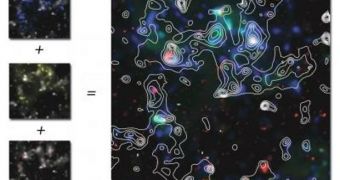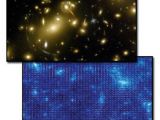One of the most used methods of analyzing the distribution of dark matter throughout the Universe is called weak gravitational lensing (WGL). At this point, our technology has not yet evolved to a point where we can observe the elusive stuff directly, so we must rely on indirect observations to assess some of its most basic properties. It is known that it mostly becomes visible through the gravitational pull it exerts on regular matter. Now, scientists have managed to extend the use of WGL to smaller cosmic structures as well, which could result in new and groundbreaking science.
In charge of the new investigation have been researchers at the US Department of Energy's (DOE) Lawrence Berkeley National Laboratory (Berkeley Lab). They say that, until recently, this observation technique could only be used to assess the influences that dark matter exerted on very large structures, such as massive galaxies and galactic clusters. By developing an innovative scaling relationship, the Berkeley Lab team was able to extend WGL to more distant, smaller objects in the Early Universe. Details of their achievements appear in the latest issue of the respected Astrophysical Journal.
“We've been able to extend measurements of mass to much smaller structures, which existed much earlier in the history of the Universe. This helps us gain a better understanding of the relationship between the normal matter in dense structures, which are seen through the X-ray luminosity, and the total dark-matter mass of these structures, as measured by the weak lensing,” Berkeley Lab Physics Division Chamberlain Fellow Alexie Leauthaud explains.
He is the first author of the journal entry, and also a member in the Berkeley Center for Cosmological Physics (BCCP), which is operated by Berkeley Lab, and the University of California in Berkeley (UCB).
“The variations we observe in the ancient microwave sky represent the imprints that developed over time into the cosmic dark-matter scaffolding for the galaxies we see today. It is very exciting that we can actually measure with gravitational lensing how the dark matter has collapsed and evolved since the beginning,” UCB Physics Professor George Smoot, the director of the BCCP, adds. He is one of the authors of the new study, as well as a member of the Berkeley Lab Physics Division. In 2006, Smoot won the Nobel Prize in Physics, for his work in establishing the anisotropies that existed in the cosmic microwave background (CMB), the relic glow that has permeated the Universe since the Big Bang.

 14 DAY TRIAL //
14 DAY TRIAL // 
